Cherries
 Two main types of cherries are produced in the United States: sweet cherries and tart or �sour� cherries, the latter being used primarily for processing. Sweet cherries are produced mainly in the Pacific Northwest and California while Michigan is the leader in tart cherry production. New York grows just less than 900 acres of cherries, 150 of which are located in eastern NY. The United States is the third-largest producer of cherries in the world. The European Union-27 is the leading cherry producer, followed by Turkey.
Two main types of cherries are produced in the United States: sweet cherries and tart or �sour� cherries, the latter being used primarily for processing. Sweet cherries are produced mainly in the Pacific Northwest and California while Michigan is the leader in tart cherry production. New York grows just less than 900 acres of cherries, 150 of which are located in eastern NY. The United States is the third-largest producer of cherries in the world. The European Union-27 is the leading cherry producer, followed by Turkey. Cherry consumption has always been good but recent information about the antioxidant health benefits has improved domestic consumption. Per person consumption is approximately 2 pounds per year.
Over the last 20 years, Cornell research and extension projects have helped growers increase yields and fruit quality by increasing tree densities and improving labor efficiency. We estimate that profitability of new high density orchards is 100 to 300% greater than the traditional low-density orchards. For more information about tree fruit production, please visit the Cornell Tree Fruit website at http://www.fruit.cornell.edu/tree_fruit/index.htm.
Relevant Events
2026 Cornell Winter Fruit Webinar Series
January 22, 2026 : Blueberry Pruning and Soil Health to Minimize Pests and Maximize Yield
January 29, 2026 : Cost of Production for Fruit Crops
February 12, 2026 : Fire Blight Management Updates
February 19, 2026 : Pink and Petal Fall Insecticides- Can We Strike the Right Balance?
March 12, 2026 : Inoculating Orchards with Mycorrhizal Fungi
March 19, 2026 : St. Peachtrick's Day - Cherry Pruning Strategies and Plum Varieties for the Northeast
2026 Northeast Extension Fruit Consortium Winter Webinar Series
February 4, 2026 : Management of Up and Coming Strawberry Diseases in the Northeastern United States
February 11, 2026 : Kiwiberry Production in the Northeast
February 18, 2026 : Heat Mitigation- Sunburn and Fruit Coloring
February 18, 2026 : The Dating Game- Updates in Lepidopteran Mating Disruption
March 4, 2026 : USEPA Endangered Species Act Strategies and Pesticide Use
March 11, 2026 : Practical Drought Management for Fruit Growers
Tree Fruit Scouting - Online Course
February 25, 2026 : Tree Fruit Scouting - Online Course
Orchard Video Resources: Winter Webinar Recordings and More
Mike Basedow, Tree Fruit Specialist
Eastern New York Commercial Horticulture
Tis the season of webinars! If you're looking for recordings of past tree fruit webinars Cornell ENYCHP has been involved in, they could be in one of a few locations….. we compiled them all into this post for you. Simply click on the webinar title to be taken directly to the recording. We recommend bookmarking this page if you'd like to come back to them in the future, and we will continue to update this listing as new webinars occur.
SWD Insecticides Quick Guide 2020
Laura McDermott, Team Leader, Small Fruit and Vegetable Specialist
Eastern New York Commercial Horticulture
June 2020 - Labeled Insecticides for Control of Spotted Wing Drosophila in New York Berry Crops - Quick Guide
Stone Fruit IPM Webinar
Mike Basedow, Tree Fruit Specialist
Eastern New York Commercial Horticulture
Prepping Your Air Blast Sprayer for Spring
Mike Basedow, Tree Fruit Specialist
Eastern New York Commercial Horticulture
Sprayers must be regularly checked over to ensure that proper maintenance has been carried out and that no outstanding repairs need to be done. Faulty sprayers contribute to increased drift levels and waste money through inefficiency and overuse of chemicals.
2019 Eastern New York Fruit & Vegetable Conference Tree Fruit Presentations

Presentations from the 2019 ENYCHP Eastern New York Fruit & Vegetable Conference held February 19-21 for the tree fruit sections.
Labeled Insecticides for Control of Spotted Wing Drosophila
Laura McDermott, Team Leader, Small Fruit and Vegetable Specialist
Eastern New York Commercial Horticulture

June 2018 - Labeled Insecticides for Control of Spotted Wing Drosophila in New York Berry Crops - Quick Guide
2018 Eastern New York Fruit & Vegetable Conference Tree Fruit Presentations

Presentations from the 2018 ENYCHP Eastern New York Fruit & Vegetable Conference held February 20th and 21st for the tree fruit sections.
Labeled Insecticides for Control of Spotted Wing Drosophila in New York Berries
A Quick Guide to Labeled Insecticides for Control of Spotted Wing Drosophila in New York Berry Crops
Compiled by Greg Loeb, Laura McDermott, Peter Jentsch, Tess Grasswitz, & Juliet Carroll, Cornell University. Updated regularly.
New fungicides labeled for use in tree fruit - all Special Local Needs Labels
Deborah Breth, Integrated Pest Management
Lake Ontario Fruit Program
The new class of fungicides, SDHI's, are now registered for use in tree fruit. Fontelis was registered last season, and Luna Tranquility and Merivon were registered this spring. They are all registered in NY as "Restricted Use" fungicides. Due to the special restrictions for use in NY, they also are Special Local Need registrations. In order to apply these materials you must have a copy of the label and the SLN label in your possession. You can access these SLN and label to study or print at these links.
The Commercial Storage of Fruits, Vegetables, and Florist and Nursery Stocks
Craig Kahlke, Team Leader, Fruit Quality Management
Lake Ontario Fruit Program
The information contained in this preliminary version of HB-66 has been assembled from information prepared by nearly 100 authors from around the world. The version posted here is a revised copy of a Draft made available online in November 2002 for author and public review and comment.
Cranberry and Cherry Fruit Worm

A number of growers have been calling with a question about blueberry clusters strung together with webbing or frass or both. Most people cannot find a larvae (although they are there!), but are alarmed with picker complaints. The pest in question is fruit worm either cranberry or cherry. Both insects have very similar life cycles and the damage is similar, but the chemical control materials differ slightly, so it will be important to be able to differentiate.
The adult moths lay their eggs in late May and early June at the base of the newly set fruit. Larvae of both
species attack green fruit. There are sex pheromones available for both pests and monitoring should begin in late April to optimize spray timing. Usually two sprays are necessary the first at petal fall and the second 10 days later. Organically approved materials include Entrust and Dipel DF. Other materials include Azasol, or Molt-X, Sevin, Malathion, Imidan, Esteem and Delegate, among others.
Check the Guidelines for more control information and visit this site for fact sheets about fruitworms: http://www.fruit.cornell.edu/berry/ipm/ipmpdfs/bbfruitworm.pdf

Upcoming Events
2026 Winter Cut Flower Webinar Series
January 6, 2026
The fifth annual CCE Cut Flower Webinar Series begins on January 6, 2026 and continues over 5 weeks on Tuesdays. This is a very popular series of online events you won't want to miss, with topflight speakers, a wide variety of subjects concerning growing cut flowers and plenty of interaction between speakers and attendees.
Tuesdays 1pm-3pm January 6, 2026 - February 3, 2026 (The webinar held on February 3 will run 1pm-4pm)
Cost: $60.00 for all five sessions, $20 for single sessions
Webinars will be recorded, and all the recordings will be sent to registrants for future review.
Expanding Farm Sales: Markets, Profits, and Branding Series
January 10, 2026
Looking to diversify where you sell your farm products? This four-part workshop series helps farmers explore new opportunities in direct-to-consumer, wholesale, and institutional markets. Learn how to meet buyer expectations, price for profitability, and build lasting relationships that support your business goals. Participants will strengthen marketing and communication skills, evaluate which sales channels best fit their farm, and connect with buyers, distributors, and local partners who can help expand their reach. Whether you're just starting out or ready to grow your market presence, this program will help you chart the right path for your farm's future.
Four Session Series: Saturdays from 10AM to Noon, January 10-January 31, 2026
Attend at one of three locations: Schoharie Extension Center - Cobleskill, NY; Otsego Education Center - Cooperstown, NY; Via Zoom
Pre-registration is requested! Fee: $25 Register Here
Any questions can be directed to Kelley Doolin at kmd322@cornell.edu
Pesticide Applicator Certification Exam Prep Course
January 13 - January 14, 2026
Join ENYCHP specialists for an in-depth review of topics covered on the NYS DEC pesticide applicator certification exam. This two-day virtual course includes explanation of key concepts on the core exam, test-taking tips for the core and category exam, practice questions, and Q&A with instructors. Course materials, including program recordings, practice exams, and DEC materials will be available to registrants after the program. This training is geared toward certification categories 1A (agricultural plant), 21 (field and forage), 22 (fruit), and 23 (vegetable).












































